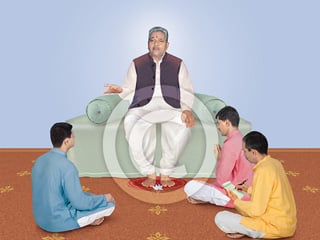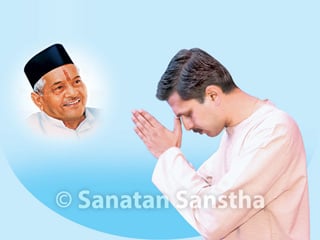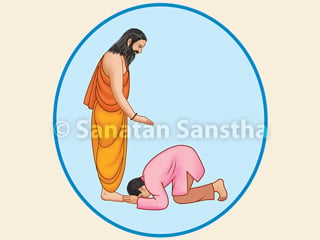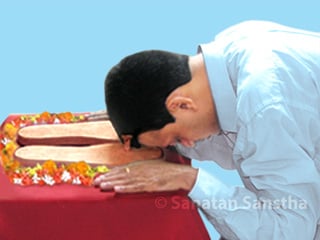Contents –
- The difference between the Guru and Teacher
- Those who give spiritual discourses (pravachans) and Gurus
- An average individual, a seeker and a Guru
- A saint and a Guru
1. Difference between Guru and Teacher
The teacher teaches for a specific period of time and only through the medium of words. On the other hand, the Guru continues to guide His disciple twenty-four hours of the day both through the medium of words and that beyond them. A Guru takes care of His disciple in any catastrophe while a teacher has hardly any concern about a student’s personal life. In short, a Guru pervades the entire life of a disciple while a teacher is associated with a student only for a few hours and that too confined to teaching a few subjects.
2. Those who give spiritual discourses (pravachans) and Gurus
‘The following table illustrates the differences in speech of those giving discourses and Gurus (saints).
|
Speech of those
giving spiritual discourses |
Speech of Gurus (saints)
|
|---|---|
| 1. Planned | Spontaneous |
| 2. Artificial | Natural |
| 3. Arises from intellect | Arises from the soul |
| 4. Quotes of Saint Tukaram, Saint Dnyaneshvar, etc. | Based on Self-realisation |
| 5. Gross | Contains divine consciousness (chaitanya) |
| 6. The listener is bored in a while | The listener can continue to listen for hours together |
| 7. Doubts in others’ minds remain unanswered | Doubts are clarified through answers without asking questions |
| 8. Mostly ego is present | Ego is never present. |
3. An average individual, a seeker and a Guru
The table below gives the desire for performing a particular action, the total action (karma) and the act (kriya) and the proportion of the two in an average individual, a seeker and a Guru. An action implies to an act performed along with a motive whereas an act is devoid of a motive.As one makes progress in one’s spiritual practice, actions of the various bodies excluding the physical body go on reducing proportionately. Thus the total action and act go on diminishing.
| Desire to perform an action |
Total of the action
and the act % |
Proportion of the
action and the act |
||
|---|---|---|---|---|
|
Action %
|
Act %
|
|||
| 1. An average individual | One’s own wish (Svechcha) | 100 | 90 | 10 |
| 2. A seeker | Others’ wish (parechcha) | 40 | 70 | 30 |
| 3. A Guru | God’s wish (Ishvarechcha) | 5 | 10 | 90 |
Saints give some guidance to accomplish some achievements, in both the materialistic as well as the spiritual realms. When a saint accepts a seeker as a disciple He becomes the latter’s Guru. A Guru guides only regarding achieving the realm without materialistic expectation. Once a saint commences His mission as a Guru His desire to help His devotees to overcome their worldly obstacles gradually decreases and finally ceases altogether.
4. A saint and a Guru
Every Guru is a saint, but the reverse is not always true. Inspite of this being so, majority of the characteristics of saints also apply to Gurus. They are given in ‘Science of Spirituality : Chapter 42 – The Spiritually Evolved’. The following table grossly compares a saint and a Guru both with a spiritual level of 80 %.
|
A saint
|
A Guru
|
|
|---|---|---|
| Love for others % |
30
|
60
|
| Service % |
30
|
50
|
| Sacrifice % |
70
|
90
|
| Writing |
2
|
10
|
| A. Quantity % |
More of spiritual
|
More of spiritual
|
| B. Nature |
experiences
|
guidance
|
| Manifest energy % |
20
|
5
|
| Spiritual evolution * |
Rapid
|
More rapid
|
* Both saints and Gurus have a spiritual level of atleast 70%. After crossing 70%, spiritual progress is faster in Gurus than in other saints. They attain the level of a Sadguru (80%) and a Paratpar Guru (90%) faster than other saints attaining the same spiritual levels. This is because They are constantly engrossed in the mission of spiritually uplifting a disciple, while saints at times perform tasks from the Great Illusion, for the sake of Their devotees.
The Great Illusion of nescience (avidyamaya) and the Great Illusion of the Guru (gurumaya)
‘The Great Illusion (Maya) is of two types, the Great Illusion of nescience and the Great Illusion of the Guru. The former entraps the embodied soul (jiva) in ignorance while the latter liberates the embodied soul from it. Synonyms for the Great Illusion of the Guru are Prabhumaya and Harimaya (the Great Illusion of The Lord). The Great Illusion of nescience is so deceptive that it does not allow one to perceive its illusory nature. Even great saints have been deceived by the Illusion of nescience. For instance Saint Eknath failed to recognise that ShrikhanDya who filled water in His home and prepared a paste of sandalwood, was The Lord Himself. Only when the Illusion of The Lord unveiled the curtain of the Illusion of nescience by appearing as another devotee from Dvarka did Nath perceive ShrikhanDya’s true form.’
Reference: Sanatan Sanstha’s Holy Text “Importance of the Guru, types and Gurumantra”


 What is the importance of Guru?
What is the importance of Guru? What is a guru and How to Find Him?
What is a guru and How to Find Him? The Guru-disciple relationship
The Guru-disciple relationship Qualities of a disciple
Qualities of a disciple Spiritual disciplines in Disciple’s life
Spiritual disciplines in Disciple’s life Guru Shishya relationship and How one should behave with the Guru ?
Guru Shishya relationship and How one should behave with the Guru ?